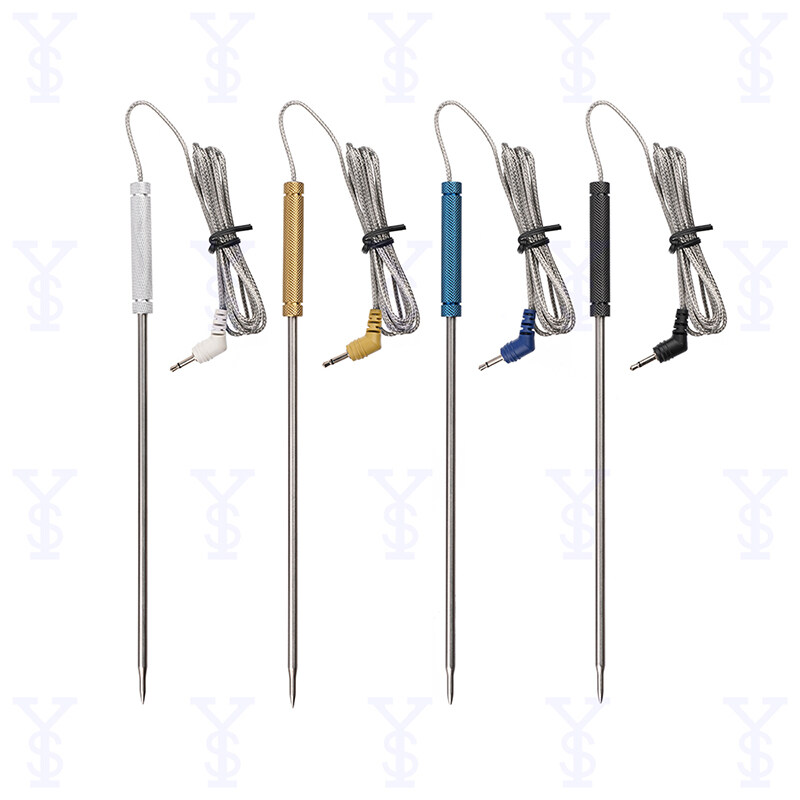ඊමේල් ආකෘතියේ දෝෂයකි
emailCannotEmpty
emailDoesExist
pwdLetterLimtTip
inconsistentPwd
pwdLetterLimtTip
inconsistentPwd


Understanding Meat Probe Temperatures
Cooking meat to the right temperature is essential for both flavor and food safety. Meat probe temperatures help ensure that your dishes are cooked thoroughly while retaining their juiciness. This guide explores safe cooking temperatures, types of meat probes, calibration techniques, and best practices for their use.
Safe Cooking Temperatures
-
Importance of Proper Temperatures
- Cooking meat to the appropriate temperature is crucial for killing harmful bacteria and ensuring food safety. The USDA provides specific guidelines for various types of meat.
-
Recommended Temperatures
- Here are some safe internal temperatures for commonly cooked meats:
- Beef, Pork, Lamb, and Veal (steaks, roasts, chops): 145°F (63°C) with a 3-minute rest time.
- Ground Meats (beef, pork, lamb): 160°F (71°C).
- Poultry (chicken, turkey): 165°F (74°C).
- Fish and Shellfish: 145°F (63°C).
- Ham (fresh or smoked): 145°F (63°C) with a 3-minute rest time.
- Here are some safe internal temperatures for commonly cooked meats:
Types of Meat Probes
-
Digital Instant-Read Probes
- These probes provide quick and accurate readings, making them ideal for checking the doneness of meat. They usually have a pointed end for easy insertion.
-
Dial Thermometers
- Typically featuring a dial face, these thermometers take longer to provide readings compared to digital options. They are best suited for large cuts of meat, such as roasts.
-
Probe Thermometers
- These can be left in the meat while it cooks, allowing continuous temperature monitoring. Many have alarms to notify when the desired temperature is reached.
-
Infrared Thermometers
- Used for surface temperature readings, infrared thermometers are not suitable for internal temperature checks but can help gauge the cooking surface's heat.
Calibration Techniques
-
Why Calibration is Important
- Regular calibration ensures that your meat probe is giving accurate readings, which is essential for food safety.
-
How to Calibrate
- Ice Water Method: Fill a cup with ice and add cold water. Let it sit for a few minutes, then insert the probe. It should read 32°F (0°C).
- Boiling Water Method: Bring water to a boil. Insert the probe, ensuring it does not touch the bottom of the pot. It should read 212°F (100°C) at sea level. Adjust for altitude if necessary.
Best Practices for Using Meat Probes
-
Insertion Techniques
- Insert the probe into the thickest part of the meat, avoiding bones and fat, as they can give inaccurate readings.
-
Multiple Probes for Large Cuts
- For larger cuts, consider using multiple probes to check different areas, ensuring the entire piece is cooked evenly.
-
Monitoring During Cooking
- If using a probe thermometer that stays in the meat, monitor the temperature throughout the cooking process to avoid overcooking.
-
Resting Time
- Remember that meat continues to cook slightly after being removed from heat. Allow for resting time as recommended, which can affect the final temperature.
-
Cleaning and Maintenance
- Clean your probes after each use to prevent cross-contamination. Follow manufacturer guidelines for care and storage.
Conclusion
Understanding meat probe temperatures is vital for anyone who enjoys cooking, whether a novice or an experienced chef. By adhering to safe cooking temperatures, utilizing the right type of meat probe, calibrating properly, and following best practices, you can ensure that your meats are both delicious and safe to eat.
Investing in a quality meat probe and mastering its use will enhance your cooking experience and elevate your culinary results, allowing you to serve perfectly cooked meals every time.

